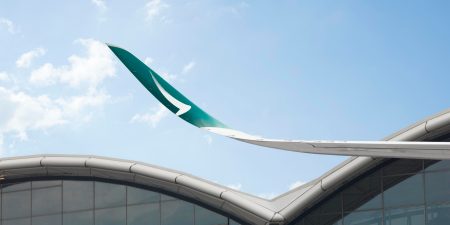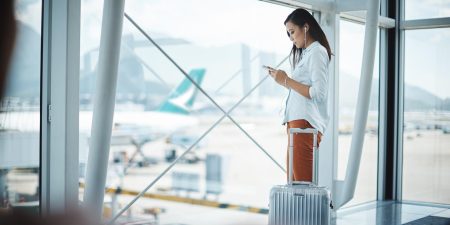
Cathay Pacific releases traffic figures for November 2022
Cathay Pacific carried a total of 526,827 passengers last month, an increase of 652.1% compared with November 2021, but a 79.9% decrease compared with the pre-pandemic level in November 2019. The month’s revenue passenger kilometres (RPKs) increased 565.5% year-on-year, but were down 73.7% versus November 2019. Passenger load factor increased by 51.7 percentage points to 78.5%, while capacity, measured in available seat kilometres (ASKs), increased by 127.2% year-on-year, but decreased by 73.1% compared with November 2019 levels. In the first 11 months of 2022, the number of passengers carried increased by 220.5% against a 33.9% increase in capacity and a 211.9% increase in RPKs, as compared with the same period for 2021.
The airline carried 103,092 tonnes of cargo last month, a decrease of 23.8% compared with November 2021, and a 42.1% decrease compared with the same period in 2019. The month’s cargo revenue tonne kilometres (RFTKs) decreased 27.8% year-on-year, and were down 38% compared with November 2019. The cargo load factor decreased by 15.6 percentage points to 66.9%, while capacity, measured in available cargo tonne kilometres (AFTKs), decreased by 11% year-on-year, and was down by 36.4% versus November 2019. In the first 11 months of 2022, the tonnage decreased by 12.6% against a 20.7% decrease in capacity and a 30.6% decrease in RFTKs, as compared with the same period for 2021.
Travel
Chief Customer and Commercial Officer Ronald Lam said: “We continue to see positive signs for our travel business. Sentiment and demand for travel out of Hong Kong continued to improve in November. We also saw increased visiting friends and relatives (VFR) traffic into Hong Kong, particularly from long-haul origins such as North America, Europe and the South West Pacific. Transit traffic via the Hong Kong hub also improved as we grow our network of destinations.
“On average, we carried about 17,600 passengers a day in November, up from around 13,000 in October. Passenger flight capacity increased about 16% versus the previous month. Overall, we operated 27% of pre-pandemic capacity levels in November.
“We continued to add more flights to more destinations last month, in particular to and from popular places in Japan as well as Southeast Asia, which saw huge demand from Hong Kong. As expected, Japan was our top destination in terms of passenger numbers while load factor on these flights stayed high at 86%. November also saw the resumption of passenger flights to Denpasar (Bali), Tokyo (Haneda) and Zurich.
Cargo
“On the cargo side, demand remained flat in November compared with the previous month despite it being the start of the traditional peak cargo period. We carried 103,092 tonnes of cargo last month, approximately 6% less than in October, while cargo flight capacity was down about 2% in November compared with the previous month. Overall, we operated about 64% of pre-pandemic capacity levels.
“Production activities in the Chinese Mainland and trade flows remained constrained. While we did witness a mild uptick in e-commerce movements into the Americas around the Black Friday shopping period, a similar surge on regional lanes was more short-lived.
“Conversely, movements of perishable goods from South America as well as Australia and New Zealand were relatively active. As such, we operated five non-scheduled services from Darwin, Australia carrying fresh seasonal produce into North Asia to capitalise on this activity.
“Building on the experience gained over the past few years and the evolving needs of the pharmaceutical industry, last month we refreshed our pharmaceuticals solution under a new name, Cathay Pharma. This has seen us enhance our customer proposition, making it easier for customers to identify all of the possible options for pharmaceutical shipments in a more streamlined way.”
Outlook
Cathay Pacific welcomes the Hong Kong SAR Government’s latest measures to facilitate travel to Hong Kong, in particular the decision to remove the Amber Code restrictions under the Vaccine Pass for inbound persons entering Hong Kong effective today. The adjustments will help further boost sentiment for travel, especially among inbound visitors, thereby aiding the resumption of travel activities and strengthening of network connectivity at the Hong Kong aviation hub.
Lam said: “As we approach the festive Christmas and New Year holiday period, travel demand continues to improve. We are further increasing our passenger flight capacity and resuming more destinations, including Sapporo, Fukuoka, Penang and Dhaka in December, as well as Phuket and Nagoya in January next year. We expect that short-haul routes to leisure destinations such as Japan and Southeast Asia will remain strong, continuing on into the Chinese New Year holiday peak as well.
“We are also extremely excited for our customers to be able to experience our elevated, premium First class service again, which is now available on our prime London Heathrow flight, CX251/CX252. First class will be coming to our Paris flight, CX261/CX260, from 18 January 2023 and our Tokyo (Haneda) flight, CX548/CX549, from 1 February. Customers departing Haneda Airport can also enjoy our signature Cathay Pacific Lounge, which reopened earlier this month.
“Regarding cargo, our expanding passenger travel network will provide our cargo customers with more destinations and greater frequencies to choose from as well. However, we expect headwinds in the air cargo market to continue in the short term until supply chains in the Chinese Mainland become more stable and inventory levels in key consumer markets reduce.”
CATHAY PACIFICTRAFFIC | NOV2022 | % ChangeVS NOV 2021 | CumulativeNOV 2022 | % ChangeYTD |
| RPK (000) |
|
|
|
|
| - Chinese Mainland | 53,816 | 150.2% | 429,520 | 55.5% |
| - North East Asia | 245,551 | 3,704.2% | 478,396 | 625.6% |
| - South East Asia | 270,586 | 858.5% | 835,108 | 307.4% |
| - South Asia, Middle East & Africa | 127,425 | 1,559.2% | 358,925 | 829.5% |
| - South West Pacific | 394,953 | 690.2% | 1,419,388 | 652.7% |
| - North America | 781,031 | 359.1% | 4,241,903 | 144.6% |
| - Europe | 743,137 | 580.7% | 3,296,724 | 217.7% |
| RPK Total (000) | 2,616,499 | 565.5% | 11,059,964 | 211.9% |
| Passengers carried | 526,827 | 652.1% | 2,002,696 | 220.5% |
| Cargo revenue tonne km (000) | 619,556 | -27.8% | 5,128,117 | -30.6% |
| Cargo carried (000kg) | 103,092 | -23.8% | 1,048,015 | -12.6% |
| Number of flights | 1,849 | -12.2% | 16,611 | 4.2% |
CATHAY PACIFICCAPACITY | NOV2022 | % ChangeVS NOV 2021 | CumulativeNOV 2022 | % ChangeYTD |
| ASK (000) |
|
|
|
|
| - Chinese Mainland | 127,912 | 55.5% | 1,085,875 | 51.0% |
| - North East Asia | 294,494 | 545.9% | 849,799 | 72.5% |
| - South East Asia | 395,516 | 301.5% | 1,420,589 | 51.2% |
| - South Asia, Middle East & Africa | 179,042 | 797.8% | 612,393 | 372.8% |
| - South West Pacific | 476,134 | 1.3% | 2,023,860 | -26.1% |
| - North America | 932,994 | 138.6% | 5,709,490 | 32.2% |
| - Europe | 928,774 | 157.5% | 3,906,261 | 68.5% |
| ASK Total (000) | 3,334,866 | 127.2% | 15,608,267 | 33.9% |
| Passenger load factor | 78.5% | 51.7%pt | 70.9% | 40.4%pt |
| Available cargo tonne km (000) | 925,416 | -11.0% | 7,221,601 | -20.7% |
| Cargo load factor | 66.9% | -15.6%pt | 71.0% | -10.1%pt |
| ATK (000) | 1,243,891 | 5.5% | 8,715,910 | -14.7% |
Glossary
Terms:
Available seat kilometres (“ASK”)
Passenger seat capacity, measured in seats available for the carriage of passengers on each sector multiplied by the sector distance.
Available tonne kilometres (“ATK”)
Overall capacity measured in tonnes available for the carriage of passengers, excess baggage, cargo on each sector multiplied by the sector distance.
Available cargo tonne kilometres (“AFTK”)
Cargo capacity measured in tonnes available for the carriage of freight on each sector multiplied by the sector distance.
Revenue passenger kilometres (“RPK”)
Number of passengers carried on each sector multiplied by the sector distance.
Cargo revenue tonne kilometres (“RFTK”)
Amount of cargo, measured in tonnes, carried on each sector multiplied by the sector distance.
Ratio:
Revenue passenger kilometres/
Cargo revenue tonne kilometres
Passenger/Cargo load factor = ------------------------------------------------------------
Available seat kilometres/
Available cargo tonne kilometres









